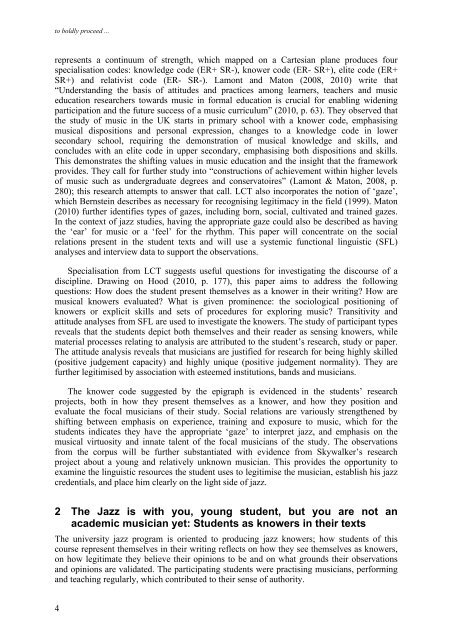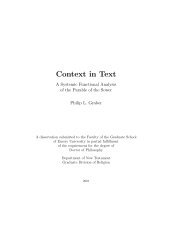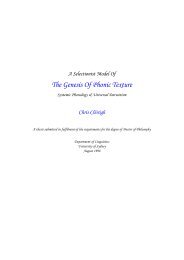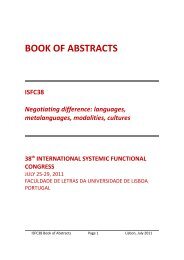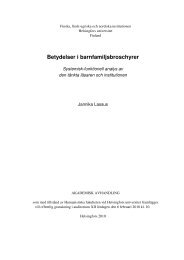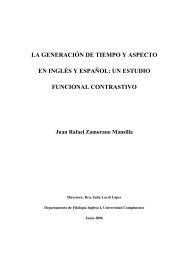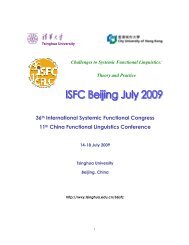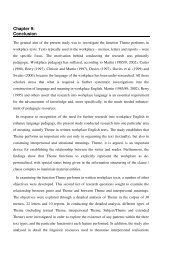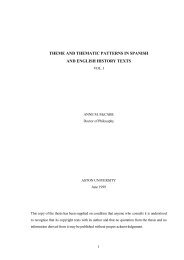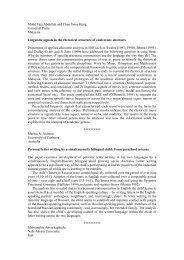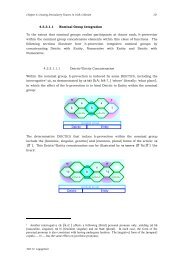the ISFC39 Proceedings - International Systemic-Functional ...
the ISFC39 Proceedings - International Systemic-Functional ...
the ISFC39 Proceedings - International Systemic-Functional ...
You also want an ePaper? Increase the reach of your titles
YUMPU automatically turns print PDFs into web optimized ePapers that Google loves.
to boldly proceed ...represents a continuum of strength, which mapped on a Cartesian plane produces fourspecialisation codes: knowledge code (ER+ SR-), knower code (ER- SR+), elite code (ER+SR+) and relativist code (ER- SR-). Lamont and Maton (2008, 2010) write that“Understanding <strong>the</strong> basis of attitudes and practices among learners, teachers and musiceducation researchers towards music in formal education is crucial for enabling wideningparticipation and <strong>the</strong> future success of a music curriculum” (2010, p. 63). They observed that<strong>the</strong> study of music in <strong>the</strong> UK starts in primary school with a knower code, emphasisingmusical dispositions and personal expression, changes to a knowledge code in lowersecondary school, requiring <strong>the</strong> demonstration of musical knowledge and skills, andconcludes with an elite code in upper secondary, emphasising both dispositions and skills.This demonstrates <strong>the</strong> shifting values in music education and <strong>the</strong> insight that <strong>the</strong> frameworkprovides. They call for fur<strong>the</strong>r study into “constructions of achievement within higher levelsof music such as undergraduate degrees and conservatoires” (Lamont & Maton, 2008, p.280); this research attempts to answer that call. LCT also incorporates <strong>the</strong> notion of ‘gaze’,which Bernstein describes as necessary for recognising legitimacy in <strong>the</strong> field (1999). Maton(2010) fur<strong>the</strong>r identifies types of gazes, including born, social, cultivated and trained gazes.In <strong>the</strong> context of jazz studies, having <strong>the</strong> appropriate gaze could also be described as having<strong>the</strong> ‘ear’ for music or a ‘feel’ for <strong>the</strong> rhythm. This paper will concentrate on <strong>the</strong> socialrelations present in <strong>the</strong> student texts and will use a systemic functional linguistic (SFL)analyses and interview data to support <strong>the</strong> observations.Specialisation from LCT suggests useful questions for investigating <strong>the</strong> discourse of adiscipline. Drawing on Hood (2010, p. 177), this paper aims to address <strong>the</strong> followingquestions: How does <strong>the</strong> student present <strong>the</strong>mselves as a knower in <strong>the</strong>ir writing? How aremusical knowers evaluated? What is given prominence: <strong>the</strong> sociological positioning ofknowers or explicit skills and sets of procedures for exploring music? Transitivity andattitude analyses from SFL are used to investigate <strong>the</strong> knowers. The study of participant typesreveals that <strong>the</strong> students depict both <strong>the</strong>mselves and <strong>the</strong>ir reader as sensing knowers, whilematerial processes relating to analysis are attributed to <strong>the</strong> student’s research, study or paper.The attitude analysis reveals that musicians are justified for research for being highly skilled(positive judgement capacity) and highly unique (positive judgement normality). They arefur<strong>the</strong>r legitimised by association with esteemed institutions, bands and musicians.The knower code suggested by <strong>the</strong> epigraph is evidenced in <strong>the</strong> students’ researchprojects, both in how <strong>the</strong>y present <strong>the</strong>mselves as a knower, and how <strong>the</strong>y position andevaluate <strong>the</strong> focal musicians of <strong>the</strong>ir study. Social relations are variously streng<strong>the</strong>ned byshifting between emphasis on experience, training and exposure to music, which for <strong>the</strong>students indicates <strong>the</strong>y have <strong>the</strong> appropriate ‘gaze’ to interpret jazz, and emphasis on <strong>the</strong>musical virtuosity and innate talent of <strong>the</strong> focal musicians of <strong>the</strong> study. The observationsfrom <strong>the</strong> corpus will be fur<strong>the</strong>r substantiated with evidence from Skywalker’s researchproject about a young and relatively unknown musician. This provides <strong>the</strong> opportunity toexamine <strong>the</strong> linguistic resources <strong>the</strong> student uses to legitimise <strong>the</strong> musician, establish his jazzcredentials, and place him clearly on <strong>the</strong> light side of jazz.2 The Jazz is with you, young student, but you are not anacademic musician yet: Students as knowers in <strong>the</strong>ir textsThe university jazz program is oriented to producing jazz knowers; how students of thiscourse represent <strong>the</strong>mselves in <strong>the</strong>ir writing reflects on how <strong>the</strong>y see <strong>the</strong>mselves as knowers,on how legitimate <strong>the</strong>y believe <strong>the</strong>ir opinions to be and on what grounds <strong>the</strong>ir observationsand opinions are validated. The participating students were practising musicians, performingand teaching regularly, which contributed to <strong>the</strong>ir sense of authority.4


